Preamble
I recently visited Vietnam and Cambodia with a tour group from Vancouver, Canada. My interest in Vietnam as a country was ignited during my undergraduate days (1968-1974) at the University of Dhaka. As a student of political science, I followed the Vietnam War and the heroic resistance by the Vietnamese people and guerilla fighters against the US troops and their killings and indiscriminate bombings. Since then, I always had a desire to visit Vietnam. The Vietnam story in many ways inspired the Bangladeshi people against the Pakistani occupation forces and our struggles for independence in 1971.
Fast forward to Summer 2023, when the tour guide from Marlin Travel inquired with us about a two-week group tour, my spouse Mohammad Zaman and I immediately signed up for the trip. There were 21 people in the Tour Group, including Nancy Lam – the tour guide, and her husband Rick. Some members in the Group were seniors. We departed Vancouver on 7th October and returned on 22nd October 2023. In this short piece, I have tried to put together the trip and our experience from my perspectives focusing on the history and people of Vietnam. To my surprise, Vietnam has fundamentally transformed in the last 50 years from a war-torn to a booming and economically prosperous country. I plan to write a separate piece later on my Cambodian experience.
Brief Profiles of Vietnam’s History and People
Currently, Vietnam has a population of over 100 million, ranked as the world’s 15th most populous country. It has a long land border with China, Laos, and Cambodia. Geographically, Vietnam is roughly divided into three parts—North, Central, and South Vietnam.
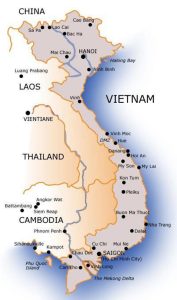
The country experienced a prolonged warfare in the 1950s, following World War II, partitioning into North and South Vietnam, with Hanoi and Saigon as capital cities, respectively. The Democratic Republic of Vietnam in the North was headed by President Ho Chi Minh, and the Republic of Vietnam, usually called South Vietnam, was led by a pro-American political regime. In 1975, Saigon fell to the North Vietnamese Army, effectively ending the Vietnam War. The reunification of the two Vietnams formally took place in July 1976 establishing the present-day Socialist Republic of Vietnam.
Vietnamese people belong to different ethnic and cultural groups. The dominant ethnic Vietnamese occupy the low-lying deltas while the highlands in the north are home to many smaller ethnic and linguistic groups. People in the Southern delta, with fertile lands, historically practiced wet rice cultivation. The agricultural economy in the Red River and Mekong delta is supplemented by forestry, fishing, and tourism, and lately by industrial and service sectors. Vietnam has three major and widely known cities: Hanoi, the capital city in the North; Da Nang, the most vibrant coastal city in the middle; and Ho Chi Minh City (HCMC)/Saigon) in the South. Saigon is the economic hub of the country.
Hanoi and Ha Long Bay
We started our trip in Hanoi, the Capital City. Our flight from Taipei landed in Hanoi around noon time. The local tour guides Luy and Khoa welcomed us at the airport. A luxury bus drove us for an hour to the city centre for lunch as it was still not check-in time at the hotel.
|
|
|
Hanoi has a population of 8 million. We found the streets busy and crowded mostly with motorcycles. According to our local tour guide Khoa, there are approximately 5 million motorcycles in Hanoi. Most households have more than one motorcycle for family use. The tour bus dropped us in front of a very colourful and huge restaurant known for its most authentic local food. It was a busy lunch hour, so we had to wait for our table. Since we had time, we walked around to see kitchen, food, and tables in the open area, crowded but well-organized. After half an hour waiting, we got a table on the second floor.
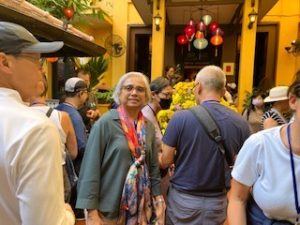
It was a ‘light” lunch with soup with local savories and a special dessert, but to me seemed a heavy lunch. It took more than two hours to finish lunch. The lunch was already in the tour “package”, but we had to pay for our drinks in Dong, the local currency. We later found that most places take US dollar. As advised earlier by Nancy, I had smaller notes (in US dollars) to pay for drinks (especially coconut) and other small purchases.
After lunch, the guide toured us around Hanoi downtown area. All government buildings in Hanoi are in yellow, a tradition that continued from the French colonial era. After checking-in at the Pan- Pacific Hanoi, we were on the bus again to visit Hoa Lo, the former prison built by the French for Vietnamese political prisoners.
|
|
|
The visit to the prison was like a horror movie. The torture of the people and political prisoners of all ages and gender by the French colonizers – for example, shackled on legs, all kinds of physical punishments, starving to death, execution, and guillotined to death – were reconstructed in murals and pictures. Dark prison cells were used to make the political prisoners morally weak. Despite the brutal suppressive techniques, the prisoners kept their contacts secretly with the communist party.
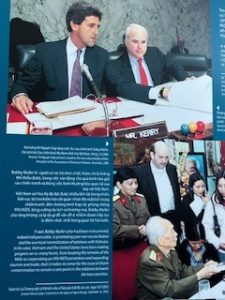 |
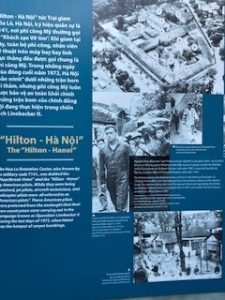 |
John McCain (right) John Kerry (left) for Reconciliation
The Vietnamese later used the same prison for the American soldiers and pilots captured during the war. John McCain was in this prison until American prisoners of war were freed to return to USA. Later, John McCain and John Kerry returned to Vietnam for reconciliation and building peace. Americans now perhaps are some of the largest investors in the country.
In the evening, we took a long walk through the city streets to a restaurant for dinner. Hundreds of people were eating outside on the streets, very crowded with nice table settings on the pavement. This way of dining is very much part of the local culture. It is cheaper too. We had dinner with six- course meals at an authentic Vietnamese restaurant.
The next day, we travelled by bus for two and a half-hour to Ha Long Bay on a 2-day cruise. Once we left the hotel in Hanoi, the bus was on the main highway that had three lanes each way. The traffic on the highway was normal. Through the window I viewed vast rice fields, coconut trees, banana plants, squash cultivation and so on. It looked so beautiful and reminded me of Bangladesh villages. We travelled through what is known as
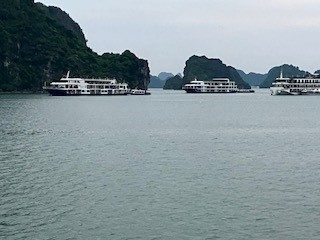
the Red River delta area, with endless rice-fields as far as the eye can see. I saw both men and women working in the fertile rice field with their traditional bamboo hats on. The bus stopped at a local pearl store as part of the tour-circuit, where the visitors saw in real time how workers made cultured pearl from oysters. The show room and the shops inside were crowded with tourists. It took another half an hour drive to the Ha Long Bay cruise terminal.
Ha Long Bay is the No. #1 tourist destination and a must see in Vietnam. It is a UNESCO World Heritage site. The limestone islets formed over millions of years of geological and geomorphological formations attract tourists from all over the world. Ha Long Bay is considered one of the New 7 Wonders of Nature.
|
|
|
We boarded the La Regina, with four decks. There were other tour groups that joined us. Our room was on level two above the water surface. It was an airconditioned room, spacious, with an antique bathtub and a separate standing shower. The room had a balcony with two chairs and a table. It was a fantastic feeling cruising on the Ha Long Bay. We were told that close to 200 small and medium cruise ships are anchored in the bay each night.
After a while, we had buffet lunch and then left the cruise ship in smaller boats for kayaking and to see the caves and more. Once we arrived at the site, we were given options for kayaking or manually operated boat ride. Three of us opted for the boat ride. The boat operator was a woman, who went through a cave that almost touched us. The cave was lighted for safety reasons. It was a fascinating experience going into the cave by boat. The operators are locals and unionized. I was told that there was gender parity in the number of boat operators. We returned to the cruise ship before sunset. After dinner, some members of the Tour Group joined squid fishing and others went for swimming as the water was calm and crystal clear.
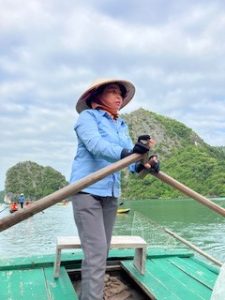
 Manually operated Boat ride
Manually operated Boat ride
The following morning, both of us joined the Tai Chi on the sundeck. We had early breakfast, and then boarded a small ferry at 8:00 am for a visit to Viet Hai Village for various prescheduled activity. Once we arrived at the Cat Ba ferry station, two of us took ride in electric golf cart; the rest biked to the Culture Conservation Centre on the island. The local guide showed us clay houses, liquor distillery made from corn, sticky rice, and herbal roots from the jungle. We found several conservation sites full of tourists. On our way back, the Group went on to a local restaurant for authentic Vietnamese food, i.e., hot pot with squid, shrimp, chicken, beef/pork, noodles, and varieties of vegetables. Our Tour Guide pre-ordered our hot pot without pork. We were proficient with use of chopsticks due to our past travels to China.
After lunch, we visited a war-time hospital in a mountain-top-cave. Close to 100 steps to the mountain top made us really exhausted. Both of us, particularly Zaman with his knee issues, needed help. The Group members assisted us and were very passionate as well as helpful. The mountain top hospital inside the cave had replicas of the patients/doctors. Many Vietnamese guerrillas and Vietcong soldiers were treated in this hospital. It was abandoned following the end of the Vietnam War. A photo of Ho Chi Minh was in one of the rooms. The local tour guide took out his red hat and honored Ho Chi Minh’s picture with a salute.
The bus then took us to the Ba Trail Dao beach, quite fancy that looked like a private beach beside a 5-Star hotel. The sandy beach was gorgeous where the bottom of water had sands without rocks and sea plants. Most members took a walk around the beach. We opted for swimming. Initially, I was scared but couple of group members taught me how to look at the beach, not the waves coming from sea. The bus returned to the Cat Ba terminal for a speedboat ride to the La Regina cruise ship. On our way back to the cruise ship, we found bay of the ocean, mountains, and a floating fishing village on the Bay. Since this was our last night on the cruise, we had a special dinner with dance and performances. The experience on the cruise ship at Ha Long Bay was simply amazing! We returned to Pan-Pacific Hanoi the next day.

We spent another two days in Hanoi. In those two days, the Group visited Ho Chi Minh Mausoleum complex—a huge site with lush green, well-maintained garden, pond with fish, and flowers. Ho Chi Minh declared Vietnam’s independence from France at the Ban Din Red Square located in the same complex. To Vietnamese, Ho Chi Min symbolized simple way of living, modesty, gentleness, and dedication to the nation as well as the people. In 1969, he spent his last days in a bunker in this complex that looked like a house built during the Vietnam war.

Another must visit place in Hanoi is the famous water puppet show in Thang Long Water Puppet Theater. After that, we went to the fourth floor of Hilton Towers for dinner. After the dinner, the local tour guide gave us two surprises: first, we visited the Ho Chi Minh Mausoleum again to attend a guard of honor ceremony. Every evening at 10:00 pm, the guards with a ceremony lower down the national flag and then hoist it in the morning. The huge compound was well-lighted. Hundreds of tourists and local people were present during the ceremony. The local guide gave us another surprise visit: railway coffee shops.
We were surprised to see many small trendy coffee shops on both sides of the railway track, crowded with foreign tourists. Two trains passed through the railway track when we were sipping drinks—coconut, coffee, and so on. The group thoroughly enjoyed this exotic experience.
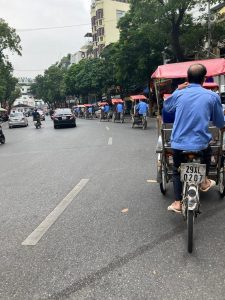
Before leaving Hanoi, we took our last fun trip on a rickshaw for an hour-long ride to get a view of the busiest part of the city. The experience was striking – busy streets full of restaurants, shops, motorcycles on the pavements, vegetable shops to fish market, construction materials to pearls store, jewellery, etc. My rickshaw ride was smooth because the driver/paddler avoided all potholes/bumps on the streets. Once the rickshaw ride was over, we visited a special coffee shop, a known hangout for locals as well as tourists. The coffee served was thick due to use of condensed milk and egg, tasty but very sugary. We also visited the Confucian Museum/Temple for an hour.
Da Nang, Hue and Hoi An
We flew to Da Nang from Hanoi. Da Nang, located in the middle of Vietnam, is a coastal city famous for its beaches. Instead of beaches, our tour included two historical sites: Hue and Hoi An. While driving along the coastal highway, I saw many big/chains 5-star hotels right along the coastlines. It took two hours from Da Nang to Hue city.
Hue: Old Capital of Vietnam (1802-1945)
A major attraction of Hue, the old capital of Vietnam, is its vast 19th century Citadel encompassing the Imperial City. Once we arrived in Hue, we went straight for dinner at the Citadel, the old Royal Palace. We had to use minibus to dine at the Citadel as the street was narrow, not designated for a bus route. After dinner, we checked in at the Melina vin Pearl hotel. This 34-floor property is currently the tallest building in Hue City and located right in the city centre.
The following day had incessant rain. Both of us were bit undecided about taking the tour because of pouring rain. Glad we changed mind and visited the Hue Citadel. We bought two raincoats (green and maroon) and borrowed two umbrellas from the hotel. The Hue Citadel built by Emperor Gia Long situated on the northern bank of the Perfume river. It was designed for the exclusive use of the Emperor and his household members. The Hue royal complex-huge and impressive-has been officially recognized by the UNESCO as a World Heritage site. Due to heavy rain, the tour-guide made the two-hour visit shorter and called electric car to transport us to the bus.

Both of us skipped visiting couple of temples due to problems with access – for one of the temples had 144 stairways. Instead, we rested at the hotel and felt refreshed. Later, in the afternoon, we took a boat ride with the team for an hour. The group checked out from the hotel in the morning. It was another unbearable rainy day. We went to Ba Na Hills, a theme park. The cable car was modern and well-maintained. The Golden Bridge, architecturally, was holding the bridge on one hand with five fingers. The Theme Park was an amusement place of carnivals, with Jurassic Park, bumping cars, and many more fun activities. After about 3 hours, we got down from the mountain by cable car, and had a late buffet lunch at the park with live music. Due to heavy rain, we were all soaked in rain waters. Both of us felt miserable; Zaman was shivering at lunch and was ready to return to the hotel. For the next three days, we experienced pouring rain in Hue and our next destination Hoi An. The team arrived in the Hoi An and checked in the hotel that evening.
Hoi An: Another Historic City
 Hoi An is another historic town, famous for its heritage and tourism. The old town was declared a World Heritage Site by UNESCO in 1999. The city buildings display a blend of local and foreign influence. We stayed at the Hoi An Historic hotel, a huge complex and design marked by French colonial heritage. The local culture is influenced both by French and Chinese elements.
Hoi An is another historic town, famous for its heritage and tourism. The old town was declared a World Heritage Site by UNESCO in 1999. The city buildings display a blend of local and foreign influence. We stayed at the Hoi An Historic hotel, a huge complex and design marked by French colonial heritage. The local culture is influenced both by French and Chinese elements.
Due to heavy rain, both Zaman and I decided to skip morning tours – i.e., scheduled visits to Fujian Assembly Hall, Old House of Tan Ky, the iconic 400-year-old Japanese covered bridge, and Trade ceramic museum. Zaman felt feverish with a running nose. Concerned by Zaman’s health situation, a physician of the tour group offered Zaman a Covid-19 test kit; the result came out negative. By that time, nearly one-fourth members of the Tour Group tested positive. Those with Covid, maintained protocol, i.e., wore a mask and sat in a separate dining table, distancing non-Covid members and skipped the tour. Zaman stayed/rested in the room. I visited the gift shop in the hotel and got some gifts for our family members in Canada. I also walked around the hotel with a raincoat and an umbrella. Lots of rainwater, with overflowing rivers and flooding everywhere on city streets. It reminded me of the rainy season and the devastations caused by non-stop rains in Bangladesh.
In the evening, I attended a cooking class. Khoa, our local guide had arranged a rickshaw for me to go to a restaurant for meeting with the group. We visited the local vegetable and spice market. The group finally arrived at the riverbank for a boat ride to attend our cooking class. It was about a forty-five-minute boat journey on the Thu Bon River, which was overflowing without high waves and rough tide. My lifejacket comforted me. The cooking instructor, a woman, showed us three dishes—how to prepare, cut, and cook. Each of us had a print copy of cooking instructions and prepared our own dish for dinner by using a stove, cooking materials, knives and so on. The philosophy was: cook your own dinner. It could be more fun and entertainment, but the weather deprived that to some extent.
The following morning, our group left the hotel for the Da Nang airport. On our way, our bus stopped at another tourist-circuit, a huge marble shop in Da Nang where beautiful Buddha marble structures and other items were on display for sale. Zaman bought a nice and expensive Kipling bag pack. I bought a purse. The flight from Da Nang to the HCMC (Vietnamese either call it the City or Saigon) took about one hour and twenty minutes.
Saigon and the Mekong Delta
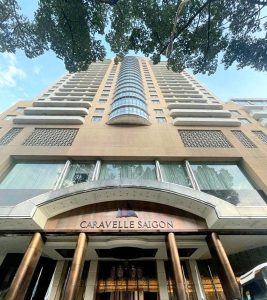
Once we arrived in the HCMC airport, our tour bus took us to Caravelle Saigon, a downtown hotel in the heart of the city. There was marble work everywhere inside the hotel. The ambience and surrounding the hotel reminded me of Paris. The tour guide told us that Saigon never sleeps. It is a very vibrant city. He also warned us about muggers, pickpockets, etc., which are vices of any major global city. However, nothing happened to any one of us who went out for mid-night shopping and night life.
The next day we left in the morning for site visits. We visited a handicrafts factory, which uses eggshells and multi-colour oyster shells for paintings. They employ people with disabilities and support them by donating its profits. The team then visited the Cu Chi Tunnels, an extraordinary network of tunnels that are more than 120 miles/193 kms in length used by the Viet Cong (guerrillas/soldiers) as a hideout and secret village during the Vietnam war. On site, a 20-minute documentary showed the impacts of the prolonged war, sufferings, famine, countless deaths, and how the tunnels were constructed.
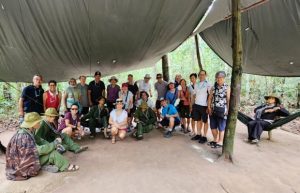
We got experience by walking through a section of the tunnel and tried to feel what life was in underground for the Viet Cong guerrillas. It was a narrow tunnel—only suitable for young and skinny people. We walked for two hours and saw American tanks, caves, traps created by the Viet Cong, how the Viet Cong cooked in the cave while hiding smokes from the American soldiers/fighter planes.
Back in Saigon, the team visited the War Museum Remnants where I found a poster in Bangla Lal Salam (Red Salute) prepared by the Communist Party of West Bengal as a symbol of appreciation to Vietnamese people fighting against the US imperialism for their independence. The museum documented photos of protests and demonstrations around the world against the Vietnam War.
|
|
|
In one of the posters, Ho Ch Minh said: ‘the people in Vietnam should rely on their own strength/determination while resisting the American Imperialist strategies.’ The same evening, we had a cruise-dinner on the Saigon River. The cruise assigned a long table to our group. The night-view around the Saigon River reminded me the night in Shanghai’s Pudong in 2016. HCMC undoubtedly is one of the most beautiful cities of the world. We both think that it is worth revisiting!
The next day, we started early morning around 8:00 am for Cai Be in Mekong Delta. It was a long two and half-our bus ride all along on the divided and elevated highway. We crossed beautiful rice fields, miles after miles. Vietnam has now turned into a rice exporting country.
The Mekong delta has fertile lands for rice cultivation. This is truly called the “rice bowl” of Vietnam. After we arrived at the dock, all of us bought ‘peasants’ hat’ before taking a motorized boat ride for 20 minutes to Cai Be Island. Upon arrival, we set off by boat to visit the floating market. We then visited a family business where they made coconut candy and crispy rice crop. The boat then took us to Tan Phong Island. We were greeted by this ‘tourist village’ with songs and performances that included stories of peasants’ life, happily married peasant couple and drunken peasant/his wife. From there, we visited a handicraft industry that showed how to prepare puffed rice, coconut candy and so on. Also, visited a working fruit orchard. We also visited a house to see how dried and processed water-hyacinth is woven into products such as baskets, bags, wallets, and shoes.

Finally, we reached at the other end of the Island where 6 paddling boats were ready for us to take to the motorized boat waiting at a distance. A woman with two paddles rowed our boat. Zaman tried to use one paddle, but rowing was arduous. While on the boat, I saw floating markets, fishing boats, boat people doing daily chores, i.e., cooking, bathing, washing clothes. Traveling through the Mekong delta was amazing and once in a lifetime experience for me. We returned to the hotel in Saigon at around 7:00 pm.
The following morning, we visited the Presidential Palace, also called Reunification (of Vietnam) Place, where the agreement between two Vietnams was signed. The Palace has large and spacious bedrooms, large dining room, cabinet meeting rooms, a huge dining hall for state dinner, room for welcoming ambassadors and dignitaries—all were luxurious and decorated. During the last days of war against the Communist party, the President of South Vietnam lived in the bunker of the Palace, where he had a small office with 4 telephones,

and a huge kitchen as generals and top officials were in the bunker. A helipad was on the top floor where signs of bombings done by North Vietnam was distinctly visible. The day North Vietnam soldiers crushed the front gate of the Palace, the talk regarding reconciliation albeit reunification started. The Vietnamese Reunification Day, i.e., April 30th, symbolized the day when the forces of North Vietnam captured Saigon (now HCMC), and thus, led the end of the Vietnam War after thirty years in 1975.
In Saigon, we had our finale with Saigon River dinner cruise. It was a large ship. There were close to 200 people on the dinner cruise. The seating arrangements in different decks were based on ticket prices. The river looked dazzling with bright lights. It was also a perfect night with clear sky and full moon.
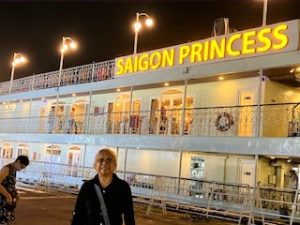
|
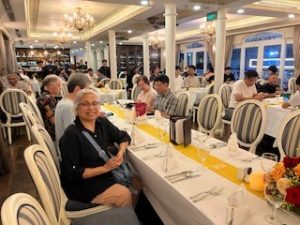 |
Dinner in Saigon Princess cruise
Our Vietnam tour was seamless and hassle free, thanks to Nancy and her Team on the ground. In 2019, prior to the Covid-19 pandemic, Vietnam welcomed over 19 million tourists annually. In 2022, it was close to 5 million, and growing gradually after the Covid-19 restrictions were withdrawn. Despite tourist dollars, concerns regarding booming tourism industry and its impact upon the country’s ecology and environment are growing. This needs to be addressed carefully, making a balance that benefit the country and its environment.

Habiba Zaman
Habiba Zaman is Professor Emeritus at Simon Fraser University. She was also an associate member of SFU Labour Studies Program. Professor Zaman is author of several books, journal articles, reports, and conference proceedings including Asian Immigrants in “Two Canadas”: Racialization, Marginalization, and Deregulated Work (2012; translated in Mandarin, 2021). She is a co-editor of Canada 150 Conference Proceedings on Migration of Bengalis (2018) https://doi.org/10.21810/sfulibrary.73. E-mail: habiba_zaman@sfu.ca

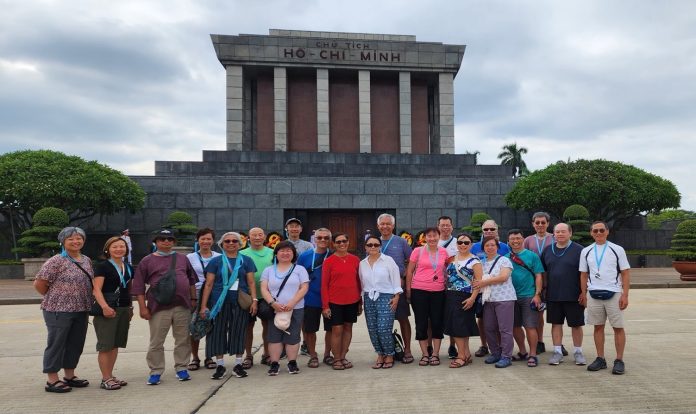
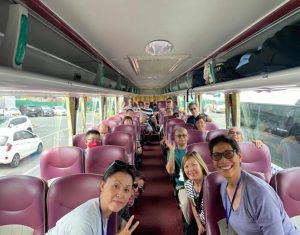
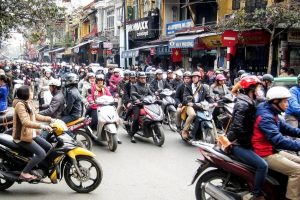

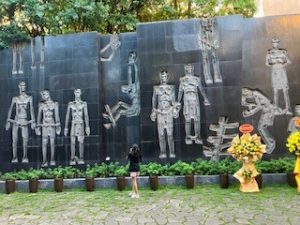


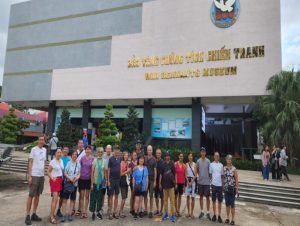
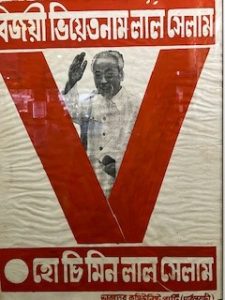
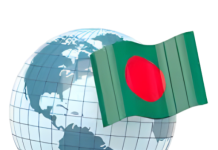
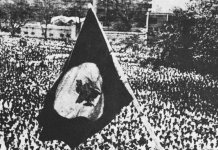
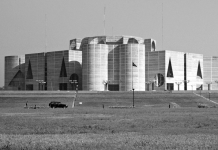
Dear Habiba,
What an interesting report of your trip. I really enjoyed reading it and I learned a lot.